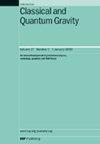Spherically symmetric collapse: initial configurations
IF 3.6
3区 物理与天体物理
Q2 ASTRONOMY & ASTROPHYSICS
引用次数: 0
Abstract
The initial state of the spherical gravitational collapse in general relativity has been studied with different methods, especially by using a priori given equations of state that describe the matter as a perfect fluid. We propose an alternative approach, in which the energy density of the perfect fluid is given as a polynomial function of the radial coordinate that is well-behaved everywhere inside the fluid. We then solve the corresponding differential equations, including the Tolman–Oppenheimer–Volkoff equilibrium condition, using a fourth-order Runge–Kutta method and obtain a consistent model with a central perfect-fluid core surrounded by dust. We analyze the Hamiltonian constraint, the mass-to-radius relation, the boundary and physical conditions, and the stability and convergence properties of the numerical solutions. The energy density and pressure of the resulting matter distribution satisfy the standard physical conditions. The model is also consistent with the Buchdahl limit and the speed of sound conditions, even by using realistic values of compact astrophysical objects such as neutron stars.球对称坍缩:初始构型
广义相对论中球形引力坍缩的初始状态已经用不同的方法进行了研究,特别是使用了将物质描述为完美流体的先验给定状态方程。我们提出了另一种方法,其中完美流体的能量密度作为径向坐标的多项式函数给出,径向坐标在流体内部的任何地方都表现良好。然后,利用四阶龙格-库塔方法求解相应的微分方程,包括Tolman-Oppenheimer-Volkoff平衡条件,得到了一个中心被尘埃包围的完美流体核心的一致模型。我们分析了哈密顿约束、质量-半径关系、边界和物理条件,以及数值解的稳定性和收敛性。所得物质分布的能量密度和压力满足标准物理条件。该模型也与布赫达尔极限和声速条件相一致,甚至通过使用紧凑天体物理物体(如中子星)的实际值。
本文章由计算机程序翻译,如有差异,请以英文原文为准。
求助全文
约1分钟内获得全文
求助全文
来源期刊

Classical and Quantum Gravity
物理-天文与天体物理
CiteScore
7.00
自引率
8.60%
发文量
301
审稿时长
2-4 weeks
期刊介绍:
Classical and Quantum Gravity is an established journal for physicists, mathematicians and cosmologists in the fields of gravitation and the theory of spacetime. The journal is now the acknowledged world leader in classical relativity and all areas of quantum gravity.
 求助内容:
求助内容: 应助结果提醒方式:
应助结果提醒方式:


